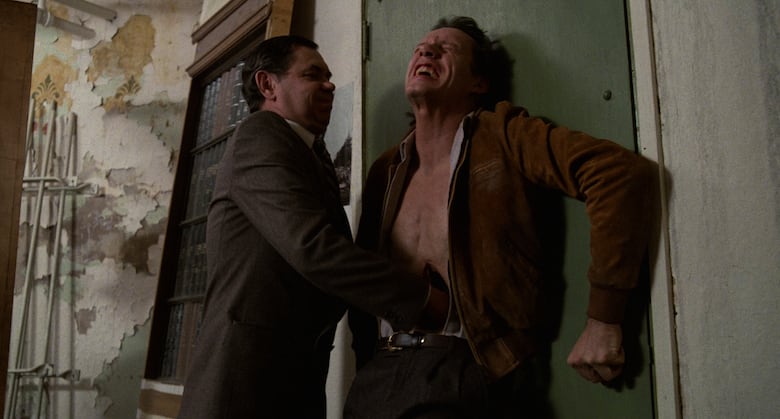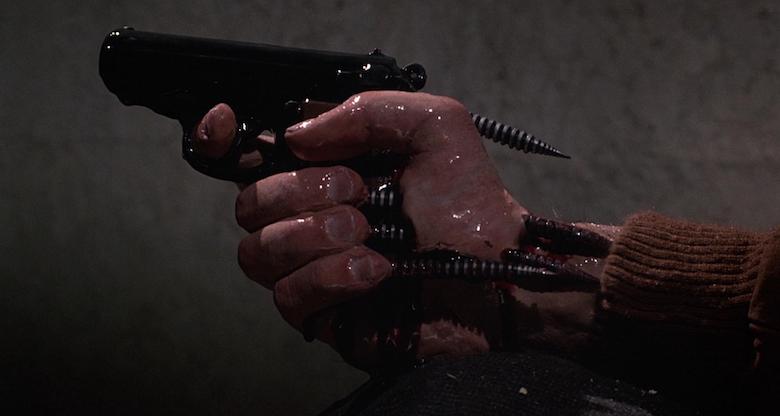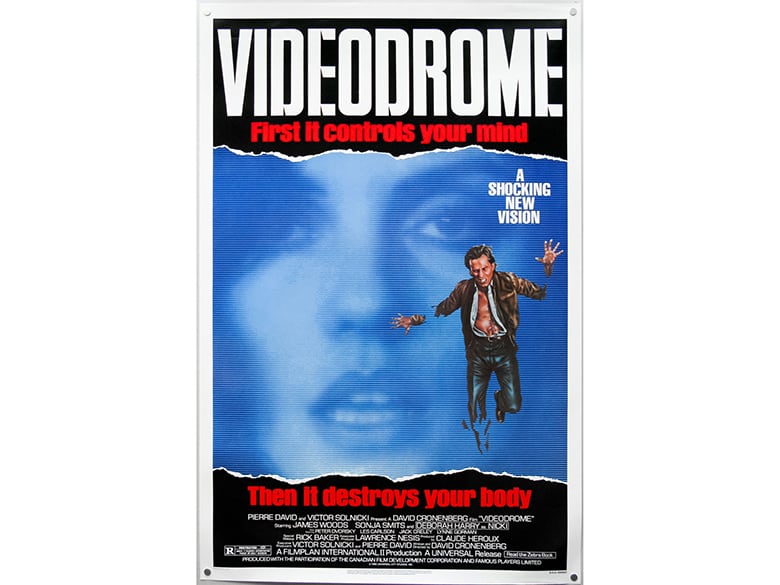Videodrome may just be the quintessential Cronenberg film. With a dark plot that traces a slowly unraveling conspiracy, stomach-churning practical effects, and themes that are open to interpretation, it’s the type of movie that urges you to watch again and again. Despite being nearly four decades old, the movie still manages to feel fresh today.
In part, this is due to the brilliant body horror. The visual effects have managed to keep this relatively obscure flick a cult classic through the ages. (Too bad that same enthusiasm wasn’t shown when the movie was in theaters.) Some sources even point to Videodrome as the crown jewel of body horror as a genre. But there’s more under the hood of this film than blood, guts, and prosthetics. Here is Videodrome explained.
The Plot of Videodrome Explained
Videodrome starts relatively calmly. We’re introduced to Max Renn (played deftly by James Woods), a nauseatingly sleazy TV executive who is bent upon achieving good ratings for his tiny channel by any means necessary. Pornography, violence, and exploitation are all fair game. “Better on TV than in the streets,” he reasons aloud at one point. As horror fans, we can’t argue much.
Early on, he and his crew of radio pirates stumble upon an obscure program called (you guessed it!) Videodrome. With each episode consisting of achingly long shots of realistic torture, Max is convinced he has stumbled upon TV gold. Meanwhile, he concurrently becomes sexually involved with Nicki Brand, the cleverly-named radio host that publicly decries over-stimulation in society while privately pursuing increasingly intense BDSM experiences with Max. After watching Videodrome with her as foreplay, Nicki becomes determined to audition for the show. And no, she never returns from her “audition.”
As this is going on, Max’s story becomes intertwined with that of Brian O’Blivion and his daughter Bianca, a confusing family of techno-futurists that seem determined to spread a pseudo-religious message through TV programming.
Max continues watching Videodrome in his free time, but shocking hallucinations start to interfere with his daily life. Cue the yonic body horror scenes centered around his stomach. Ugh…

The hallucinations get worse, and Max puts two and two together: Videodrome is no regular TV program. The torture and murder on the show are real, and something about the program is causing his brain to break down. Returning to Bianca O’Blivion, he learns that Videodrome creates brain tumors in those who watch it.
Things get bleaker: it turns out Max’s trusted pirate, Harlan, was working for Videodrome’s producers in an effort to take over Max’s TV channel and spread the disease throughout the unwashed masses. Thanks, dude.
The film takes a more frantic pace, and Max manages to fight off the Videodrome tumor’s influence – only after killing his partners at his TV program. With a new determination, he sets off to kill those who created Videodrome and create a brighter future for the rest of us sorry, undiscerning TV viewers. He succeeds, and then kills himself in a brilliantly dramatic fashion.
So, happy ending, sorta?
Bodily Autonomy in the New World
With a narrative as strange as this one, it’s difficult to wrap it up with a bow and say, “Here, we now have Videodrome explained.” But, any attempt at analyzing this movie must rightfully begin with the body horror. Unusual orifices, a hand chewed off to reveal a bloody robotic stump, a brain fighting its way out of a fractured skull – this stuff is not only the gnarly visual centerpiece of the film, but it has an important purpose.
Nearly all of the body horror results from the Videodrome program itself. The veiny, pulsating TV is part of Max Renn’s surreal hallucinations caused by his brain tumor, and the violence at the end of the film comes from Max’s brain being reprogrammed. These are all highly stylized and dramatized instances that show just how bad things can become when we lose control of our bodies and our actions.

In the world of the movie, a shadowy cult is out to take our bodily autonomy away from us. They want to use television as a means to control us. The idea of mass media turning us all into mindless drones is nothing new, but the concept of it physically changing our bodies is. Cronenberg really drives this point home – Max’s brain chemistry doesn’t just slightly change, there is a massive tumor that grows upon it. This is not exactly subtle storytelling. He is taking our fears of technology and ramping it up to 11.

Of course, the lessons about bodily autonomy here are more complicated than “big business is bad, mass media is controlling us.” One of the more interesting dynamics in the film relating to this issue is that of Max and Nicki. Despite being a bonafide purveyor of softcore filth, Max is utterly shocked by Nicki’s ownership over her own body and sexuality. Max can watch Videodrome – a snuff series documenting hardcore torture – without batting an eye, but Nicki burning herself with a cigarette for sexual pleasuer makes him cringe in disgust.
Max’s fear of Nicki’s own body autonomy reaches its pinnacle when she decides she wants to be a “contestant” on Videodrome. As she tells Max that she was “made for that show,” he leaps at her and commands her to not audition for it. Why is that? Is he so madly in love with her that he can’t stand the idea of her being hurt? No, not really – he casually hurts her during sex, and this would just be an extension of that, albeit without him involved. Their relationship isn’t portrayed as anything beyond physical pleasure and hyperstimulation. I
It’s not a leap to the idea that Max is simply focused on controlling what she can and can’t do with her body. Despite her feeling it is her destiny to appear on Videodrome – the natural endpoint of her pursuit of pleasure – he wants to keep her from doing so. In both his career and his personal life, Max is in charge of the pleasures that other people have access to.
This perhaps makes it ironic that Max’s own bodily autonomy is ripped from him by Videodrome – his mind and his body are forever transformed simply by consuming what he allows others to consume. But, interestingly enough, the movie leaves us with more questions than answers. Nicki does seemingly die for Videodrome, and that feels tragic. Max dies as a hero, but is his role in society that much more defensible than the creators of Videodrome? It’s hard to say.
Videodrome in a Modern Context
Videodrome was clearly made as a critique of the most popular form of mass media in the 1980s – television. The scenes of homeless shelters being turned into glowing TV parlors exaggerate this point enough that even the least interested viewer would pick up on it. Yet, despite TV not being the dominant form of media in today’s culture, the movie still feels quite relevant… perhaps even more than ever.
I’m not going to sit here and give a boomer lecture on how TikTok is ruining our brains. I personally think that there are many positives that social media brings to our daily lives. But it would be remiss to say that watered-down versions of Videodrome’s predictions haven’t entered the mainstream. Our access to media is constant – we always have a form of Videodrome’s television shelters in our pockets.

Whether this is truly a good or a bad thing depends on who is taking advantage of this fact. In Videodrome, the technology behind the brain tumors aren’t necessarily evil. Spectacular Optical Corporation certainly used them for dastardly purposes, but Brian O’Blivion was determined to use the technology to help the public (this was also the not-so-coincidental reason why he got taken out by the Videodrome guys).
— FOUNDATIONS OF HORROR —
Further explore these subgenres and tropes. more>>
#Body horror | #Sex and Gender horror | Technology is Scary | Science is Scary

This is also how we see this play out in reality. There are legitimately evil actors out there that try to use modern day mass media to brainwash the public into holding fringe, dangerous opinions – think the alt-right pipeline and how would-be harmless technological processes like the Youtube algorithm are harnessed to radicalize people towards violence. This is not far off from the reality posited by Videodrome.
But, luckily, the average person isn’t being that brainwashed when they sit down and scroll TikTok or Instagram reels. But, of course, the scenes scattered throughout Videodrome of unhoused people mindlessly sitting down and bathing in TV glow feel startlingly miserable. It feels like they are being brainwashed… even if that’s not the case. Perhaps the true lesson here is that losing control of either our minds or our bodies is never worth it. Even if the brainwashing benefits us, is it truly worth it? Sure, social media may feel harmless, but are we sacrificing something inherent to our humanity when our brains force us to keep scrolling for one more hit of dopamine even when we want to stop?
Eh, it’s probably fine. Let’s just hope TikTok never learns how to transmit brain tumors through iPhone screens. When that happens, you’re free to start panicking.
Last Updated on December 16, 2022.

